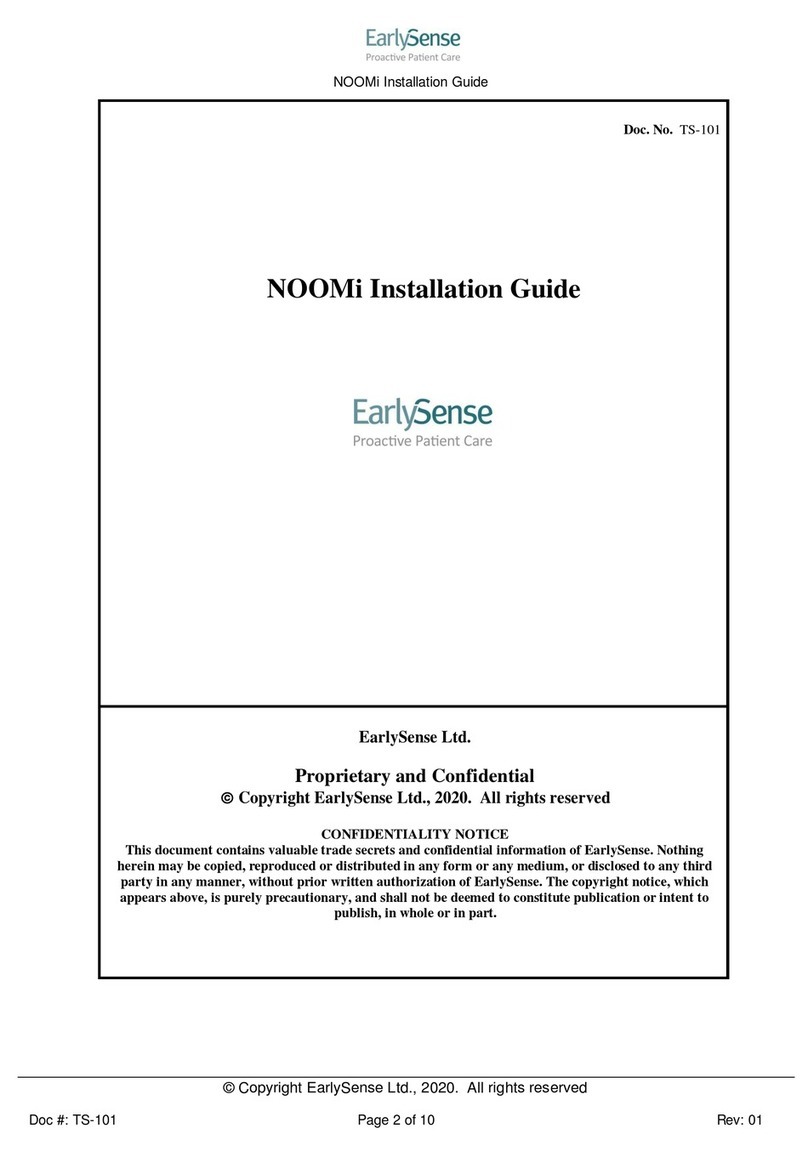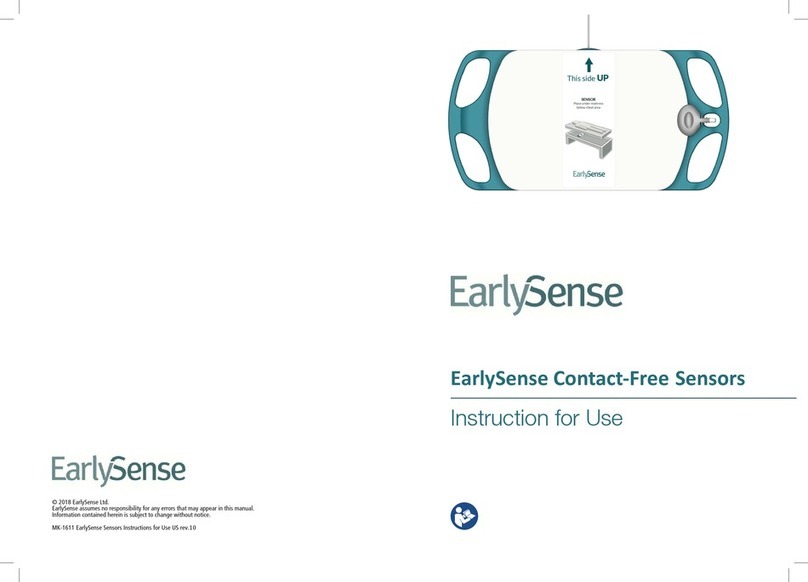
•The system should be operated within a temperature range of 5-40°C (41-104F). The non-condensing
relative humidity conditions allowed for Sensing Units are 30-95% and 15-93% for the Insight Device,
atmospheric pressure: 700-1060 hPa for the whole system including Sensing Units.
•Do not use a damaged system. The use of damaged components might result in the malfunctioning of
the system.
•Avoid splashing liquids on any part of the system. Do not allow conductive fluids to leak into the active
circuit components of the system as this may cause a short circuit, which could result in an electrical fire.
In this event, only fire extinguishers approved for use on electrical fires should be used. Care should be
taken when an EarlySense Sensing Unit is placed under the mattress for patients with poor bladder
function or control, including small children.
•Do not share the bed with another person or pet during the EarlySense InSight System recording session.
Sharing the bed could affect the effectiveness of the system and the accuracy of the measurements.
•Avoid using heating blankets. Use of heating blankets could affect the safety or effectiveness of the
EarlySense InSight System and void the system's warranty.
•Do not use the EarlySense InSight System for patients who weigh more than 200 kg (440 Pounds). Usage
of the system for such patients might result in malfunction of the Sensing Unit
•The patient should not have direct contact with the Sensing Unit. A mattress, pad or mattress cover
should always be placed as a barrier between the Sensing Unit of the EarlySense InSight System and the
patient. Patients should be frequently checked to ensure direct contact does not occur.
•If used by multiple patients, the Chair Sensing Unit should be covered by clean bed sheet to prevent
cross-contamination of the users.
•Careful oversight should be provided when EarlySense InSight System is used with children.
•False alerts may occur in some situations. The alert must be identified and understood. The cause(s) of
the false alerts must be addressed whenever possible to eliminate the possibility of repeated false alerts
and alert fatigue which might result in a failure to respond to an actual alert situation.
•All wireless systems are prone to intermittent signal dropout. Make sure that the patient only has
conditions which can tolerate intermittent monitoring interruptions. The InSight Device is the alerting
monitor. Alert delays were measured between the InSight Device and RCD and the same alert from the
RCD to the InSight Device. Delays are less than 10 total seconds, not including any hold-off settings set
by the clinical facility. However, network speeds vary and the system’s performance may vary,
depending on the speed of clinical facility network.
•Alert limit settings are patient- or facility-specific. The clinician must set and verify on the RCD Unit that
alert limits are appropriate for each patient. Failure to set alert limits properly can lead to false alerts or
failure to alert. Alerting will only work properly if set up properly.
•The usage of EarlySense InSight System on the bed or chair, close to any adjacent source of vibration,
might influence the accuracy of the system's measurements or create periodic interferences with the
measurements.
•The InSight System does not support life & nurses are required to continue their standard practice The
EarlySense InSight System is not intended for monitoring high risk situations where ECG monitoring is
required. The most reliable method of patient monitoring combines close personal surveillance with
correct operation of the monitoring equipment.
•It is strongly recommended that the InSight Unit be installed with redundant power supplies.
•External wireless alerting devices as used by the hospital should be used as secondary to the alerts as
provided by the EarlySense system.
•When utilizing EarlySense CDS as the Remote Control and display device (RCD), configuring the possibility
to remotely access the CDS via tablets or other portable devices should be performed by EarlySense
authorized technicians and requires authorization from the facility’s IT/Biomed for network setup.
•EarlySense InSight should not be used adjacent to or stacked with other equipment and if adjacent or
stacked use is necessary, the InSight System should be observed to verify normal operation.





























